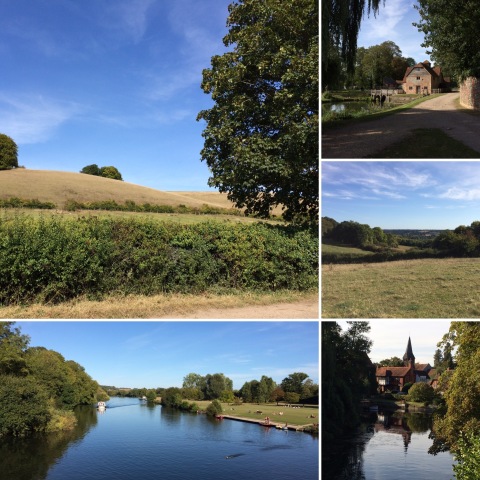We may be back from our long-distance walk, but down south the weather is still warm and summery and it would have been a shame not to make the most of it by going for a walk today. We picked one of the slightly shorter walks we'd rejected over the summer as not quite long enough to be good practice for Scotland, though at 8.25 miles today's only just didn't make the grade (and in fact it turned out to be more like 9.25 miles as we had to divert slightly at the end to avoid walking down a busy road which the book swore had a footpath, but if so it was in stealth mode).

The walk we chose started in Pangbourne, on the Berkshire side of the Thames, but in fact Pangbourne only seemed to have been chosen as a starting point because of the availability of car parking. Having managed to find our way to Pangbourne despite the best efforts of Google maps, which appears to have something against the A329 and instead sent us down a tiny road with lots of very narrow bits and across Whitchurch toll bridge, we immediately crossed back over the toll bridge (fortunately there are no tolls for pedestrians) to the Oxfordshire side and walked from Whitchurch-on-Thames to Mapledurham (a typical Oxfordshire Chilterns village whose greatest claim to fame is probably pretending to be a village in Norfolk in the film The Eagle Had Landed), passing Hardwick House on the way (something which surprised us both, as neither of us had realised Hardwick House was in Oxfordshire), as well as fields full of alpacas and horses. We then returned to Whitchurch by a different path, further from the river and climbing up and down through beechwoods and across grassy Chiltern slopes. The weather was glorious, with enough of a breeze to stop it from being too hot, though as after a few weeks away I've clearly lost my getting-ready-for-a-walk-routine and had managed to leave my sunhat at home I was quite glad of the shady parts too. We also passed lots of bushes absolutely laden with ripe blackberries and picked enough for a crumble for pudding tonight, though we could have picked more if we'd had more plastic bags with us.

The walk we chose started in Pangbourne, on the Berkshire side of the Thames, but in fact Pangbourne only seemed to have been chosen as a starting point because of the availability of car parking. Having managed to find our way to Pangbourne despite the best efforts of Google maps, which appears to have something against the A329 and instead sent us down a tiny road with lots of very narrow bits and across Whitchurch toll bridge, we immediately crossed back over the toll bridge (fortunately there are no tolls for pedestrians) to the Oxfordshire side and walked from Whitchurch-on-Thames to Mapledurham (a typical Oxfordshire Chilterns village whose greatest claim to fame is probably pretending to be a village in Norfolk in the film The Eagle Had Landed), passing Hardwick House on the way (something which surprised us both, as neither of us had realised Hardwick House was in Oxfordshire), as well as fields full of alpacas and horses. We then returned to Whitchurch by a different path, further from the river and climbing up and down through beechwoods and across grassy Chiltern slopes. The weather was glorious, with enough of a breeze to stop it from being too hot, though as after a few weeks away I've clearly lost my getting-ready-for-a-walk-routine and had managed to leave my sunhat at home I was quite glad of the shady parts too. We also passed lots of bushes absolutely laden with ripe blackberries and picked enough for a crumble for pudding tonight, though we could have picked more if we'd had more plastic bags with us.